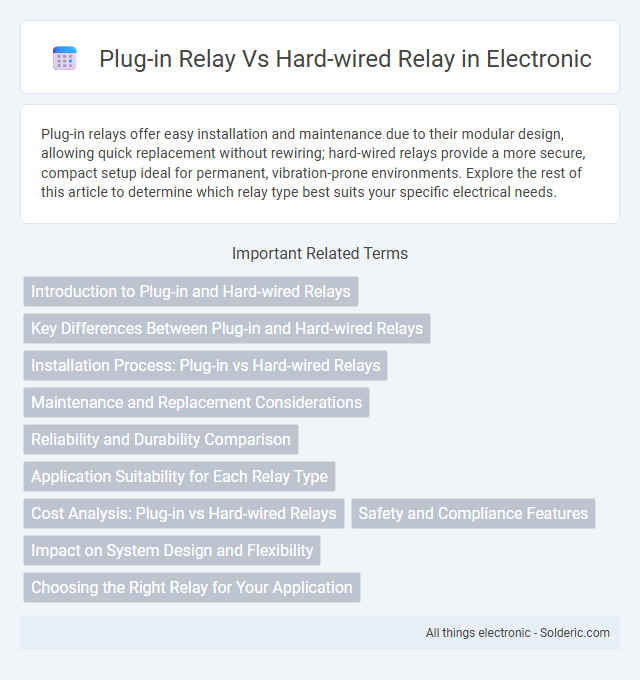Plug-in relays offer easy installation and maintenance due to their modular design, allowing quick replacement without rewiring; hard-wired relays provide a more secure, compact setup ideal for permanent, vibration-prone environments. Explore the rest of this article to determine which relay type best suits your specific electrical needs.
Comparison Table
| Feature | Plug-in Relay | Hard-wired Relay |
|---|---|---|
| Installation | Easy, socket-mounted | Requires direct wiring |
| Maintenance | Quick replacement | Time-consuming repair |
| Flexibility | Interchangeable relays | Permanent wiring setup |
| Durability | Moderate, prone to wear in contacts | High, secure connections |
| Cost | Higher initial cost | Lower initial cost |
| Application | Control panels, automation | Custom circuits, fixed installations |
| Space Requirements | Compact, modular design | May require more wiring space |
Introduction to Plug-in and Hard-wired Relays
Plug-in relays feature a modular design allowing easy installation and replacement through a socket base, enhancing maintenance efficiency in control panels. Hard-wired relays are directly soldered or wired into circuits, offering compact installation with potentially higher durability in vibration-prone environments. Selection between plug-in and hard-wired relays depends on requirements for flexibility, space constraints, and application-specific reliability.
Key Differences Between Plug-in and Hard-wired Relays
Plug-in relays offer easy installation and replacement due to their modular design, while hard-wired relays provide a more secure and compact setup by directly connecting to the circuit. You'll find plug-in relays typically used for applications requiring frequent maintenance or testing, whereas hard-wired relays excel in environments demanding durability and minimal wiring complexity. Voltage ratings, contact configurations, and mounting options also differentiate these relay types, impacting their suitability for specific electrical systems.
Installation Process: Plug-in vs Hard-wired Relays
The installation process of plug-in relays is faster and more convenient, as they can be directly inserted into a socket or relay base without the need for manual wiring. Hard-wired relays require precise wiring connections to terminal blocks or circuit boards, demanding more time and technical expertise during installation. Plug-in relays offer easier maintenance and replacement, reducing downtime in industrial and control system applications.
Maintenance and Replacement Considerations
Plug-in relays offer easier maintenance and faster replacement due to their modular design, allowing you to swap out faulty units without disconnecting wiring. Hard-wired relays require more downtime as technicians must carefully disconnect and rewire each connection during replacement. Regular inspection of plug-in relay sockets can prevent contact wear, while hard-wired relays demand more meticulous installation checks to avoid wiring issues.
Reliability and Durability Comparison
Plug-in relays offer ease of replacement but may have slightly lower long-term reliability due to potential contact wear from frequent plug-in cycles. Hard-wired relays provide greater durability and stable connections, minimizing failure risks in critical industrial applications where consistent performance is essential. Choosing the right relay type depends on your system's need for maintenance convenience versus maximum operational robustness.
Application Suitability for Each Relay Type
Plug-in relays excel in applications requiring frequent replacement or easy maintenance due to their modular design, making them ideal for control panels and automation systems with high downtime sensitivity. Hard-wired relays suit environments demanding robust, vibration-resistant connections, such as industrial machinery and heavy-duty equipment, where reliability under harsh conditions is critical. Your choice depends on balancing ease of service versus durability in the specific application context.
Cost Analysis: Plug-in vs Hard-wired Relays
Plug-in relays generally incur higher initial costs due to their modular design and easy replacement features, which reduce labor expenses over time. Hard-wired relays tend to be more cost-effective upfront but often result in increased maintenance and downtime costs because of more complex installation and repair processes. Analyzing total ownership costs reveals that plug-in relays offer better long-term savings for applications requiring frequent relay changes or upgrades.
Safety and Compliance Features
Plug-in relays offer enhanced safety with their easily replaceable modules, reducing downtime and minimizing electrical hazards during maintenance compared to hard-wired relays. Hard-wired relays provide robust, permanent connections that comply with stringent industrial safety standards but require careful handling to prevent wiring errors that compromise compliance. Both relay types must meet certifications such as UL, IEC, and CE to ensure adherence to electrical safety and performance regulations.
Impact on System Design and Flexibility
Plug-in relays offer enhanced system flexibility by allowing easy replacement and upgrades without extensive rewiring, significantly reducing downtime and maintenance costs. Hard-wired relays provide a more compact and secure connection within control panels, which can lead to greater reliability in harsh environments but limit adaptability for future changes or expansions. Choosing between plug-in and hard-wired relays directly influences the scalability and maintainability of electrical control systems, where plug-in relays support modular design and hard-wired relays cater to fixed, high-vibration applications.
Choosing the Right Relay for Your Application
Selecting the right relay depends on the application's frequency of use, maintenance needs, and installation complexity. Plug-in relays offer easy replacement and flexibility, making them ideal for applications requiring frequent maintenance or quick swaps, while hard-wired relays provide more secure, permanent connections suited for high-vibration environments. Consider factors like load capacity, space constraints, and environmental conditions when deciding between plug-in and hard-wired relay solutions.
Plug-in Relay vs Hard-wired Relay Infographic

 solderic.com
solderic.com